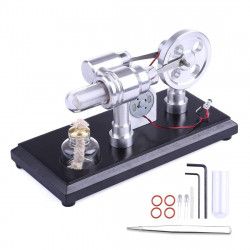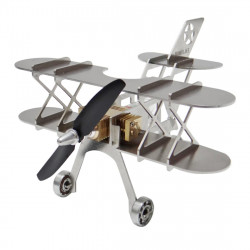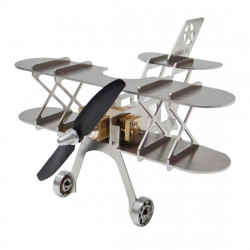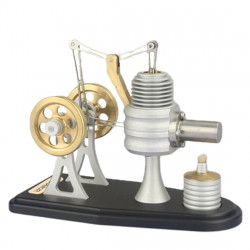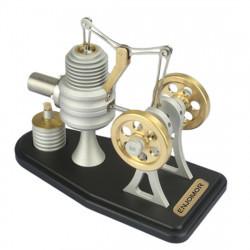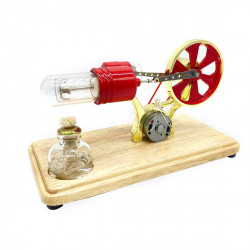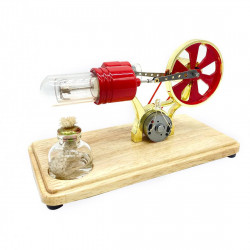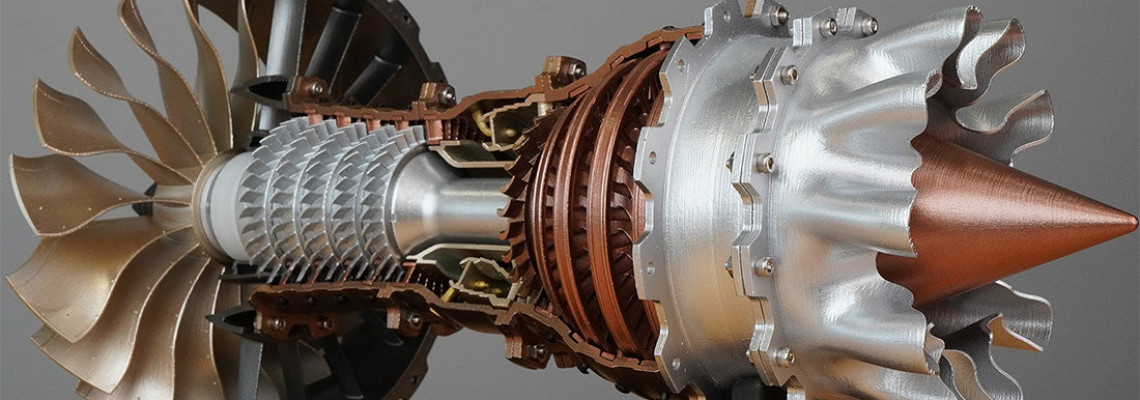
The Working Principle of Jet Engine
An enormous thrust from the jet engines propels the aircraft forward with considerable force, enabling it to fly at high speeds.
The basic idea of all jet engines and gas turbines is the same. The engine uses a fan to draw air in at the front. The air pressure is increased using a compressor. The compressor is composed of several blades that are fastened to a shaft. The air is compressed or squeezed by the high-speed spinning blades. Fuel is sprayed onto the compressed air, and an electric spark ignites the mixture. The flaming gasses expand and shoot out through the nozzle at the rear of the engine. The engine and the aeroplane are propelled forward as the gas jets blast backwards. The heated air travels through a second set of blades known as the turbine to the nozzle. The compressor and turbine are connected to the same shaft. The compressor spins when the turbine spins.
The graphic below depicts the airflow through the engine. The air circulates both through and around the engine's core. As a result, some parts of the air are highly heated while others get cooler. At the engine exit location, the hot air and colder air combine.
What is Thrust?
The forward force propels the engine, and consequently, the aircraft's onward thrust is called. Sir Isaac Newton says, "Every action has an equal and opposite reaction." This idea is applied to engines. The engine inhales a lot of air. The air is slowed down, compressed, and heated. Numerous rotating blades drive the air through them. This air can reach temperatures up to three thousand degrees when combined with jet fuel. The force of the air turns the turbine. Ultimately, the air pushes rearward out of the engine as it departs. The plane moves forward as a result.
Parts of a Jet Engine
Fan - The first part of a turbofan is the fan. The big rotating fan draws in a lot of air. The majority of the fan's blades are composed of titanium. After that, it accelerates and divides this air into two sections. The other engine components work upon one section as it continues through the "core" or centre of the engine.
The second section "bypasses" the engine's core. It travels to the back of the engine, generating a large portion of the force that moves the aircraft forward via a duct that encircles the core. In addition to giving the engine more thrust, this colder air also helps to quiet the engine.
Compressor: The engine core's first part is the compressor. The compressor consists of numerous bladed fans that are connected to a shaft. The compressor raises the air pressure by compressing it, entering it into increasingly smaller spaces. As a consequence, the air's energy potential rises. The combustion chamber receives the compressed air.
Combustor: Fuel and air are combined in the combustor, where they are ignited. Up to 20 nozzles are used to spray fuel into the atmosphere. The gasoline and air mixture ignites, creating a high-energy, high-temperature airflow. Hot, expanding gasses are created when the fuel burns with the oxygen in the compressed air. The combustor's interior is frequently composed of ceramic materials to create a heat-resistant chamber. The temperature can get over 2700°.
Turbine: The turbine blades rotate due to the high-energy airflow entering the turbine from the combustor. A shaft connects the turbines, which rotates the compressor's blades and the front intake fan. This spin somewhat depletes the high-energy flow that powers the compressor and fan. The turbine's blades rotate as the gases created in the combustion chamber pass through it. The jet's turbines rotate hundreds of times. They are attached to shafts with many ball-bearing sets between them.
Nozzle: The engine's exhaust duct is called the nozzle. This is the engine component that generates the plane's propulsion. With the colder air that avoided the engine core, the energy-depleted airflow that passed the turbine creates a force as it exits the nozzle that moves the engine and, consequently, the aircraft forward. A forward thrust is created when the hot and cold air combine to form an exhaust that is released. A mixer, which mixes the lower temperature air bypassed in the fan with the higher temperature air from the engine core, may come before the nozzle. The engine is quieter, thanks to the mixer.
The First Jet Engine - A Short History of Early Engines
The idea that a rearward-channeled explosion could move a machine forward quickly was initially proposed by Sir Isaac Newton in the 18th century. His third law of motion served as the foundation for this hypothesis. The plane travels ahead while the hot air rushes backwards through the nozzle.
The first aviation engine, a three-horsepower steam engine, was used by Henri Giffard to power an airship. The object was too heavy to fly.
With the aid of a coal-fired steam engine, Felix de Temple constructed a monoplane in 1874 that could fly a short hop down a hill.
Otto Daimler created the first gasoline engine in the late 1800s.
American Hiram Maxim attempted to use two coal-fired steam engines to propel his triple biplane in 1894. For a few seconds, it was in the air.
Powered by heated coal, the early steam engines were typically far too heavy to fly.
American inventor Samuel Langley created a steam-powered aircraft model. In 1896, he successfully piloted the Aerodrome, an unmanned aircraft with a steam-powered motor. Before it ran out of steam, it flew for nearly a mile. He then attempted to construct the Aerodrome A, a full-sized aircraft with a gas engine. It was launched from a houseboat in 1903 and crashed right away.
The Wright Brothers piloted The Flyer, a gas-powered aircraft with 12 horsepower, in 1903.
From 1903, the year of the Wright Brothers' first flight, until the late 1930s, aircraft were propelled solely by a gas-powered reciprocating internal combustion engine with a propeller.
The first turbojet engine was created and patented in 1930 by British aviator Frank Whittle. In May 1941, the Whittle engine made its maiden successful flight. This engine had a combustion chamber, a single-stage turbine, a nozzle, and a multistage compressor.
Hans von Ohain developed a comparable concept in Germany while Whittle worked in England. In August 1939, the German Heinkel He 178 became the first aircraft to successfully deploy a gas turbine engine. It was the first flight propelled by a turbojet in history.
General Electric produced the nation's first jet engine for the US Army Air Force jet plane. In October 1942, the XP-59A experimental aircraft made its first flight.
Types of Jet Engines
Turbojets
The turbojet engine's fundamental concept is straightforward. In the compressor, air drawn in through an aperture in the front of the engine is compressed three to twelve times its initial pressure. The fluid mixture is heated to between 1,100°F and 1,300°F by adding fuel to the air and burning it in a combustion chamber. The compressor is driven by the hot air produced after passing past a turbine. The pressure at the turbine discharge will be almost double the atmospheric pressure if the compressor and turbine operate efficiently. This extra pressure is directed to the nozzle, creating a high-velocity stream of gas that generates thrust. Using an afterburner can result in significant gains in thrust. A second combustion chamber comes before the nozzle and after the turbine. The gas in front of the nozzle gets hotter thanks to the afterburner. Thrust increases by roughly 40% during takeoff and a significantly higher proportion at high speeds when the plane is in the air due to this temperature increase.
One type of reaction engine is the turbojet. Expanding gasses in a reaction engine exert intense pressure against the engine's front. After sucking in the air, the turbojet squeezes or compresses it. The turbine rotates as the gasses pass past it. These gases propel the plane forward as they bounce back and shoot out of the back of the exhaust.
Turboprops
A turboprop engine is a jet engine coupled to a propeller. The propeller is driven by a shaft that is turned by the hot gases in the turbine at the back. Turboprops power a few small airlines and cargo planes.
Like the turbojet, the turboprop engine comprises a compressor, combustion chamber, and turbine. The turbine is powered by the air and gas pressure, which generates power to operate the compressor. At speeds under 500 miles per hour, the turboprop engine outperforms a turbojet engine in propulsion efficiency. Modern turboprop engines have propellers with smaller diameters but more blades to operate efficiently at significantly higher flying speeds. The scimitar-shaped blades have swept-back leading edges at the tips for increased flight speeds. Propfans are engines that have these propellers.
Turbofans
A big fan at the front of a turbofan engine draws air in. The engine is quieter at low speeds and produces more significant push since most of the air flows around its exterior. Today, turbofans power the majority of aeroplanes. All the air entering a turbojet's intake goes through the gas generator, comprising the turbine, combustion chamber, and compressor. Only a part of the air entering a turbofan engine enters the combustion chamber. The rest is either combined with the gas-generator exhaust to create a "hot" jet or is ejected straight as a "cold" jet after passing via a fan or low-pressure compressor. This type of bypass device aims to increase thrust without using more fuel. It accomplishes this by lowering the velocity and raising the overall air-mass flow within the same total energy supply.
Turboshafts
This type of gas turbine engine functions similarly to a turboprop system. It isn't a propeller driver. Instead, it powers the rotor of a helicopter. The helicopter rotor's speed is determined by the turboshaft engine's architecture, not by the gas generator's rotational speed. This allows the generator's speed to be adjusted to regulate the amount of power generated while maintaining a steady rotor speed.
Ramjets
The ramjet, which has no moving parts, is the most basic type of jet engine. Air "rams" or is forced into the engine by the jet's speed. In essence, it is a turbojet without any rotating machinery. The fact that its compression ratio is entirely dependent on forward speed limits its use. Below the speed of sound, the ramjet produces relatively little push overall and no static thrust.
Consequently, a ramjet vehicle needs an aircraft or assisted takeoff. This kind of jet is used in spacecraft, and the majority of its applications have been in guided missile systems.
